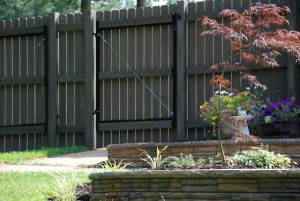Wood is the most common building material used for outdoor construction. Whether you’ve got a wooden deck, pergola, walkway, garden shed, screen or fence made of wood, it’s a good idea to stain and seal it before the onset of summer.
Even though rot-resistant lumber like redwood, and wood that was pressure-treated in the factory, will resist rot, it won’t last indefinitely without regular maintenance. And if it wasn’t treated wood that was used, it’s going to deteriorate a lot more quickly. Generally all outdoor wood should have a fresh coat of stain and sealer at very least every two years to make it look better and ensure its durability. Untreated wood should be stained and/or sealed every year.
Of course if you live in Georgia, and used a reputable McDonough fence contractor for your fence installation, it’s very likely that your fence, deck and  other outdoor structures built with wood will have been professionally stained and sealed at the time. But by their very nature, fences, decks and every other type of outdoor wooden structure will be constantly exposed to the elements, including harsh sunlight and damaging moisture from rain, hail and snow, so ongoing maintenance is very important.
other outdoor structures built with wood will have been professionally stained and sealed at the time. But by their very nature, fences, decks and every other type of outdoor wooden structure will be constantly exposed to the elements, including harsh sunlight and damaging moisture from rain, hail and snow, so ongoing maintenance is very important.
Fence Company Tips and Tricks for Staining and Sealing Wood
Preparation is Key Before you do any form of staining or sealing it is essential to clean the surface and make sure it is dry and smooth. If necessary you will have to strip off old paint, varnish or sealers. If the wood is badly weathered or has been affected by mildew then it should be bleached. You might also have to do some sanding.
Use the Best Product for the Job Before you start staining or sealing, you also need to be sure you are using the right product for the job. Some stains will also seal the wood, some won’t. Similarly some sealers will add color to the wood, while others are transparent or semi-transparent. Also, some products are formulated specifically for purpose – for example for fences or decks, not both. If you want the grain of the wood to show, look for a semi-transparent or transparent fence stain that won’t hide the grain. Ideally use a product that will penetrate the wood and leave a nice even finish.
Follow the Manufacturer’s Instructions This might sound like a no-brainer, but you might be surprised at how many people don’t bother to read labels. Typically the instructions will state how the product should be applied (for instance by brushing, rolling and/or spraying), and whether it should be thinned or not, and whether it is advisable to use a respirator if spraying. Generally products shouldn’t be applied in direct sunlight or if it’s likely to rain.
Clean Up When You’re Done If you make a mess on adjacent surfaces it’s essential to clean them as quickly as possible. This isn’t usually an issue for fences unless they have been used alongside the house, garage or an outbuilding. Read the manufacturer’s instructions to see if there are any warnings; for instance some stains might cause spontaneous combustion.
These fence company tips will help you stain and seal your own fencing effectively. But if you don’t want to go the DIY route, either contact the company that did your fence installation, or look for a contractor that offers professional fence staining services.
Natural Enclosures is a highly reputable McDonough fence contractor that only uses Wood Defender products, including specially formulate fence and deck stains. We also offer deck and fence staining services for people who would prefer an experienced professional to do the job for them.
